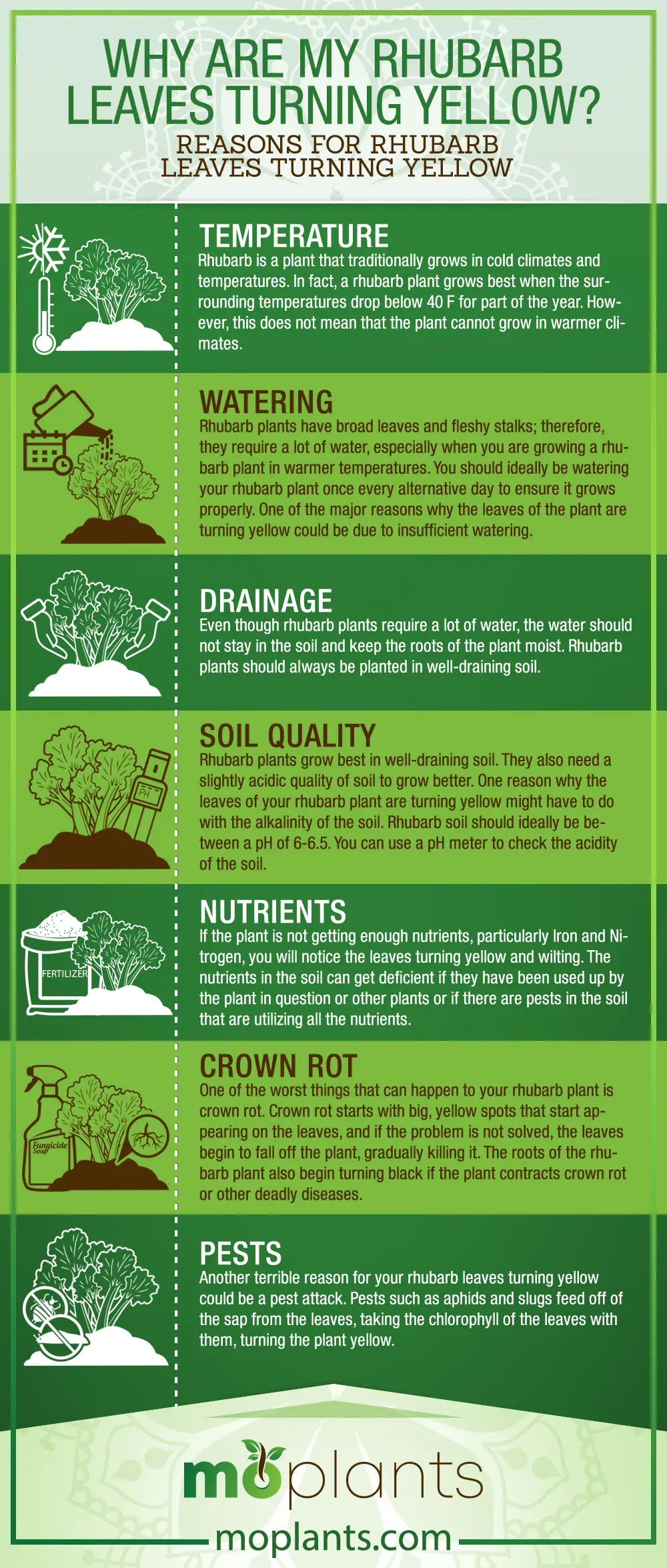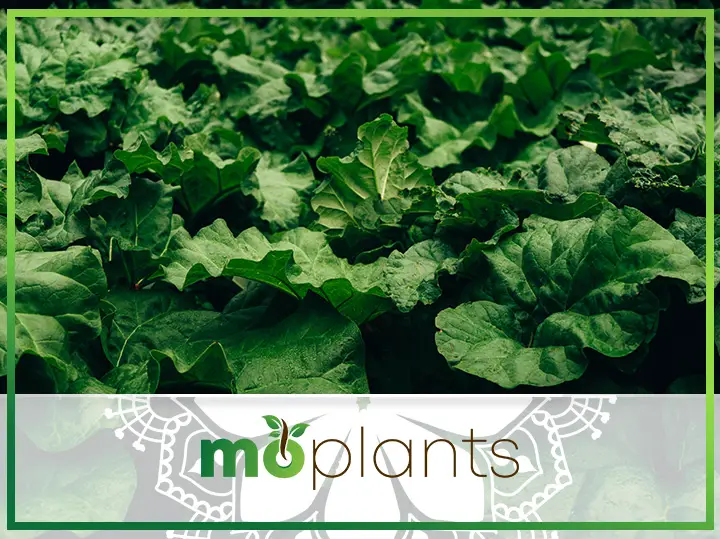All plant parents know that the plants they own deserve the utmost love and care to flourish. And growing any plant is a time-consuming process. Some of them want to be left alone until they don’t, and others want all the attention except when they don’t.
The rhubarb is one such plant as well. Typically, the rhubarb plant grows in colder temperatures, and if you want to grow rhubarb in your backyard, you need to give it all the love and care it deserves.
If your care is lacking in any way, one of the issues that spring up in rhubarb plants is that their leaves might start turning yellow. Of course, the natural concern you might have if you see yellow leaves on your rhubarb plant is if they would affect the taste of the stalk and the overall quality of the plant.
And the answer is yes, the stalk would be affected by yellow leaves, as would the overall quality of the plant. So if you see yellow leaves on your rhubarb plant, you want to get to the bottom of the situation as quickly as possible, and here are some of the possible reasons why this is happening:
Reasons For Rhubarb Leaves Turning Yellow
There are a myriad of reasons why your rhubarb leaves are turning yellow. Close inspection of the plant can help you get to the bottom of the situation as well. Here are some of the reasons why you might be seeing yellow leaves on your rhubarb plants:
Temperature
Rhubarb is a plant that traditionally grows in cold climates and temperatures. In fact, a rhubarb plant grows best when the surrounding temperatures drop below 40 F for part of the year. However, this does not mean that the plant cannot grow in warmer climates.
Growing rhubarb in warm climates will require more care, though. If you simply plant it and give it standard levels of care, the plant will not be able to grow to its maximum potential. And if you are giving it standard levels of care in a hotter climate, you might see some issues, such as a soft stalk that is greenish instead of red and yellow leaves. The stalk of the plant might also be softer than you want a rhubarb stalk to be.
Therefore, if your rhubarb plant is getting too hot, you should expose it to filtered sunlight instead of direct sunlight, especially during the summers. The plant can be exposed to indirect or filtered light with the help of a screen or blinds.
Watering
Rhubarb plants have broad leaves and fleshy stalks; therefore, they require a lot of water, especially when you are growing a rhubarb plant in warmer temperatures. You should ideally be watering your rhubarb plant once every alternative day to ensure it grows properly. One of the major reasons why the leaves of the plant are turning yellow could be due to insufficient watering.
However, it would help if you also were careful not to overwater the plant as well. If you are watering the plant multiple times a day or every day, you are also in the wrong here. This could also be a reason why the plant is becoming susceptible to yellowing leaves or other issues that slowly become more visible. You should also reduce the quantity of water you are giving your rhubarb plant during the winter months since lots of water during winter could also make the plant susceptible to overwatering.
Drainage
Even though rhubarb plants require a lot of water, the water should not stay in the soil and keep the roots of the plant moist. Rhubarb plants should always be planted in well-draining soil.
If the soil in which your rhubarb plant is planted remains moist for a day or two after you have watered it, it means that the soil is very densely packed, and the water takes a long time to leave the soil. This makes the roots of the plant submerged, which could greatly damage the plant.
If the soil of your plant is not well-draining and retains water for a long time, it could be one of the reasons why the leaves of the plant are turning yellow.
To check the drainage quality of the soil, you can use moisture sticks or simply touch the surface of the soil with your hand. If the soil is still moist after a day or two of being watered, you need to improve the drainage quality of the water.
Soil Quality
As we have already mentioned, rhubarb plants grow best in well-draining soil. They also need a slightly acidic quality of soil to grow better. One reason why the leaves of your rhubarb plant are turning yellow might have to do with the alkalinity of the soil. Rhubarb soil should ideally be between a pH of 6-6.5. You can use a pH meter to check the acidity of the soil. A higher pH will explain the yellowing leaves as well.
If the soil of your rhubarb plant is too alkaline, you should add some acidic materials to the soil to increase its pH, which will help to prevent further yellowing of the leaves.
Nutrients
If the plant is not getting enough nutrients, particularly Iron and Nitrogen, you will notice the leaves turning yellow and wilting. The nutrients in the soil can get deficient if they have been used up by the plant in question or other plants or if there are pests in the soil that are utilizing all the nutrients.
To revitalize the plant from a nutrient deficiency, you can replenish it with fertilizer. You should ideally make use of a fertilizer that is rich in nitrogen and iron and will replenish those stores for your rhubarb plant. The best time to fertilize your rhubarb plant is during the early days of spring.
Crown Rot
One of the worst things that can happen to your rhubarb plant is crown rot. Crown rot starts with big, yellow spots that start appearing on the leaves, and if the problem is not solved, the leaves begin to fall off the plant, gradually killing it. The roots of the rhubarb plant also begin turning black if the plant contracts crown rot or other deadly diseases.
If you catch the crown rot in its early stages, it is possible to reverse the damage. You need to start by removing all the leaves that have yellow patches on them carefully from the plant. After that, you should apply a mild fungicide to the plant. If you choose a fungicidal agent that is too strong, it will affect the stalk of the rhubarb plant, rendering it inedible.
You can even make your own mild fungicide with the help of some baking soda, liquid soap, and water. Simply make the mixture with a tablespoon of baking soda, a teaspoon of liquid soap, and around a gallon of water. Apply the solution to the leaves and the stalks of the plant for a few days till all the signs of the crown rot disappear.
Pests
Lastly, another terrible reason for your rhubarb leaves turning yellow could be a pest attack. Pests such as aphids and slugs feed off of the sap from the leaves, taking the chlorophyll of the leaves with them, turning the plant yellow.
To get rid of pests, you need to use a mild and effective insecticide. If your rhubarb plant has been affected by slugs, you need to make use of a special slug killer to get rid of them.
You can even make your own insecticide spray for your plants to get rid of any pests that are turning the rhubarb leaves yellow. You can take 1-2 tsp of liquid soap and mix it with a cup of any vegetable oil you have on hand. Use a tablespoon of the mixture with half a liter of water and spray it on any parts of the plant where you can see the pests.
Just like with other plant diseases, it is important to get rid of pests as soon as you see them instead of letting them fester on your plants for a long time. The longer the pests keep attacking the rhubarb, the harder it will be for you to recover the plant.
Infographic

What To Do When Rhubarb Leaves Turn Yellow?
So your rhubarb’s leaves have started turning yellow. Do you immediately begin inspecting the problem and fixing it?
No, the first step should be to remove all the leaves that have been affected. Make sure you remove them carefully with the help of clippers instead of just tearing them off to prevent harming the plant in any way.
If you let the yellow leaves stay on the plant even after the problem has been fixed, they will affect the health of the plant. These leaves will take up vital nutrients from the plant and essentially waste them. It is better to remove these leaves and wait for healthy, green leaves to grow in their place. This way, you will be ensuring that the plant remains healthy and grows to its maximum potential as well.
Will Yellow Leaves Affect The Stalk Of The Plant?
Many people plant rhubarb plants with the intention of eating the stalk after it matures. The stalk can be cooked to make sauces and delicious rhubarb pies as well.
Of course, for the best kind of rhubarb pie and edible stalk, you want the plant to grow healthily. If there are too many yellow leaves on the rhubarb plant, they will certainly affect the health of the plant. If the plant is unhealthy, you can be almost sure that the stalk will also be affected. Rhubarb stalks on unhealthy plants are soft and not as crunchy as healthy rhubarb stalks. They also often don’t taste as good. In fact, many rhubarb stalks that are grown in warmer climates without proper care are greenish in color instead of the vibrant red that we are all looking for.
So if you wish to consume the stalk of the plant at any point, you should remove the yellowing leaves as soon as possible and get to the bottom of the issue.
When Should You Worry?
While yellowing leaves are always a cause of concern on a rhubarb plant, there is no reason to worry right off the bat. If you have caught the yellow leaves in their early stages, you can easily begin by removing them and then inspecting what is wrong with the plant. If the issue is a simple one such as overwatering, too much heat, or poor soil quality, simply changing the conditions will help to revive the plant and help it grow to the best of its capability.
You should begin worrying about the plant if there are far too many yellow leaves. This often means that the plant had been showing signs of distress for a long time which were ignored for the most part. Revitalizing the plant and helping it grow in a completely healthy state would be a very difficult task in this situation.
You should also worry if the rhubarb’s leaves are yellowing and falling off as well. This means that the plant is in life-threatening distress. Either you have neglected to care for the plant properly, or it has contracted a disease such as crown rot.
Conclusion
Rhubarb plants are naturally grown in colder temperatures, but with the proper love and care, they can grow in warmer climates as well. If you see the leaves of your rhubarb plant turning yellow, it could mean a lot of things, but since the plant is resilient, it can almost always spring back on its feet if you give it the care it needs at the time. Yellowing leaves almost always signal a point of concern, but they can be rectified if caught in their early stages. If you let the yellow leaves remain, the plant could suffer a lot more.

